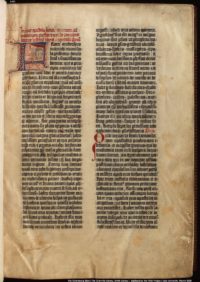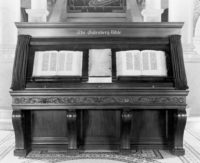The Gutenberg Bible is prized as the earliest full-size book printed in Europe with moveable type. Johann Gutenberg and his colleagues Johann Fust and Peter Schoeffer printed the Vulgate, the Latin translation of the Bible written by Saint Jerome in the 5th century, in Mainz in 1455. Of that first run of the first printed book, 48 copies have survived, only twenty of them complete. It is so important and so rare that collectors spend hundreds of thousands of dollars on individual pages of a Gutenberg Bible.
 The Library of Congress’ copy is especially rare. It was printed on vellum (animal skin parchment), not paper. Of the 48 surviving Gutenberg Bibles, 12 were printed on vellum and only three of those perfect, complete, intact copies of the Bible on vellum are known to survive. The LoC’s is one of the three complete ones and it is the only one of them to have been printed in three volumes. It is a spectacular example, the type deeply and cleanly impressed even though it was one of the first works produced on the brand-new moveable type printing press. The other vellum Bibles are at the Bibliothèque Nationale de France in Paris and the British Library in London.
The Library of Congress’ copy is especially rare. It was printed on vellum (animal skin parchment), not paper. Of the 48 surviving Gutenberg Bibles, 12 were printed on vellum and only three of those perfect, complete, intact copies of the Bible on vellum are known to survive. The LoC’s is one of the three complete ones and it is the only one of them to have been printed in three volumes. It is a spectacular example, the type deeply and cleanly impressed even though it was one of the first works produced on the brand-new moveable type printing press. The other vellum Bibles are at the Bibliothèque Nationale de France in Paris and the British Library in London.
For more than 350 years after its publication, the Bible belonged to the Benedictine abbey of St. Blasius in the Black Forest, Baden-Württemberg, Germany. In 1809, it was transferred to Abbey of St. Paul in Carinthia, southern Austria. It was bought by inventor, chemist and avid collector Otto Vollbehr for $250,000 in 1926. Vollbehr never actually held the book in his extensive collection. He planned to sell it in the United States — part of the sales pitch he made to St. Paul’s, in fact, was that he would sell it to an “American church prince” — but since he was hardly going to schlepp the precious and delicate three volume set all over the States, he made a sort of preview pamphlet and schlepped that around the country instead along with a collection of thousands of incunabula he was trying to sell.
 In 1928 the incunabula went on display at the Library of Congress. Vollbehr offered to sell the collection and the Bible to the Library. It took some doing in the wake of the Great Depression, but on July 6th, 1930, President Herbert Hoover signed the act of Congress authorizing the purchase of 3,255 volumes and the St. Blasius-St. Paul Gutenberg Bible for a total of $1.5 million.
In 1928 the incunabula went on display at the Library of Congress. Vollbehr offered to sell the collection and the Bible to the Library. It took some doing in the wake of the Great Depression, but on July 6th, 1930, President Herbert Hoover signed the act of Congress authorizing the purchase of 3,255 volumes and the St. Blasius-St. Paul Gutenberg Bible for a total of $1.5 million.
It has been on display in the corridor off of the Great Hall of the Thomas Jefferson Building, originally out in the open on a handsome wooden display, then in a closed case. The case is no longer up to snuff so it is being replaced with a new one custom designed to exhibit and protect one of the most precious books in history.
An 11-foot-tall vertical case has been designed for the Gutenberg Bible to meet exact specifications for its long-term conservation. It will be kept at a consistent, cool temperature of 50 degrees and a consistent humidity to help preserve the 563-year-old book, according to Elmer Eusman, chief of the Library’s Conservation Division. The case also includes a new early warning system for fire prevention that will constantly monitor the air.
Frosted mirrors and illumination within the display will create a special effect, emphasizing the Bible in a new way. Resting on a small cradle, the Bible will appear as if it’s floating. The design is meant to celebrate the historic book. Exhibition text will be presented on one side of the case for visitors.
On Friday, the Bible was taken off public view for the first time in more than 70 years to make the necessary arrangements for the installation of the new case. The case was built off site and will have to be broken down into component parts, moved to the Library of Congress and rebuilt The new case has been built by a vendor off site. It will be deconstructed, moved into the Library and rebuilt on site in the Thomas Jefferson Building. That will take place on October 29th. The Bible will move in to its new digs a month or so later after thorough environmental testing has been performed.
“An 11-foot-tall vertical case has been designed, kept at a consistent, cool temperature of 50 degrees and a consistent humidity.” …Of course, 11ft = 335.28 cm and -indeed a rather cool temperature- tempF(50) = tempC(10).
In a letter of 12 March 1455, Enea Silvio Piccolomini, the later Pope Pius II, wrote as papal legate in Germany to his mentor cardinal Juan de Carvajal about a visit to the Frankfurt trade fair in October 1454 in excitement:
————-
“All that has been written to me about that marvelous man seen at Frankfurt is true. I have not seen complete Bibles but only a number of quires of various books of the Bible. The script was very neat and legible, not at all difficult to follow—your grace would be able to read it without effort, and indeed without glasses.”
————-
:hattip:
——–
PS: As far as his colleagues Johann Fust and Peter Schoeffer are concerned:
“Fust loaned 800 guilders (with an interest of 6 percent) to Johannes Gutenberg with which to start his original project. Later another large sum of money was handed over from Fust to Gutenberg. At this point, Fust felt as if he needed to be included as a partner on the project since he had now invested so much. All in all Gutenberg ended up having to pay 1,200 guilders to Fust along with all of the completed Bibles, unfinished books, and his workshop. From that point on Gutenberg was hardly ever heard from again and Fust went into partnership with Peter Schoeffer. Schoeffer had learned all the fine skills of printing from Gutenberg.
A November 1455 legal document records that there was a partnership for a “project of the books,” the funds for which Gutenberg had used for other purposes, according to Fust. The court decided in favor of Fust, giving him control over the workshop and half of all printed Bibles. By 1456, the expenses of the Bible project had proliferated, and Gutenberg’s debt now exceeded 20,000 guilders. Thus, Gutenberg was effectively bankrupt, but it appears he retained (or re-started) a small printing shop, and participated in the printing of a Bible in the town of Bamberg around 1459, for which he seems at least to have supplied the type.”
Who is the vendor that built the new case?